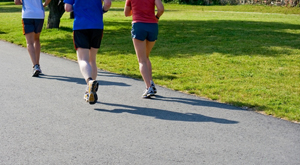Q & A with Mike Furci
07/31/2008
Furci Home / Fitness Channel / Bullz-Eye Home
Q: Mike,
Your “Fitness Myth Busters” article was a good one. I have to say it was quite entertaining.
I am currently very active at the gym and have been for about four months now. Cardio five days a week, trying to watch my diet and strength training about four to five times per week. Of course, when you start to do something to improve yourself, everyone seems to have an opinion and tells you what you are doing wrong, thus my reason for going on the Web and viewing your site.
Because I was being told so many different things, I recently decided to hire a personal trainer to get a professional opinion. He tells me in order to lose weight (I would like to lose 20 pounds) I should be weight training, and is starting me off with some different machines and moves, and then I do cardio. But I have friends who insist that I should not be doing any weights until I get to my desired weight or I will never get to my desired weight. It is so confusing.
Any way, have a nice day.
Janet
A: Janet,
Opinions are like assholes ... I'm sure you've heard that phrase.
 The friends who are insisting you should not weight train until you reach your desired weight haven’t the slightest idea what they’re talking about. This is one of the worst mistakes one can make when trying to lose body fat. When humans lose weight, we lose both fat and muscle. This is a physiological fact. Losing muscle while dieting will have a detrimental effect on your body. Muscle drives the metabolism. The more we have, the faster our metabolism and visa versa. If you do not weight train while dieting, you will lose precious muscle and your metabolism will suffer.
The friends who are insisting you should not weight train until you reach your desired weight haven’t the slightest idea what they’re talking about. This is one of the worst mistakes one can make when trying to lose body fat. When humans lose weight, we lose both fat and muscle. This is a physiological fact. Losing muscle while dieting will have a detrimental effect on your body. Muscle drives the metabolism. The more we have, the faster our metabolism and visa versa. If you do not weight train while dieting, you will lose precious muscle and your metabolism will suffer.
Cardio should be considered icing on the cake. For decades, studies have shown that moderate activity has little or nothing to do with effective weight lose. If you’re going to take the time to do cardio, make sure you are performing intervals. Don't waste your time with low intensity garbage like walking. Perform intervals two to three times per week. Do not do more than 30 minutes per workout, including a five minute warm-up and five minute cool-down. Your diet and weight training are the most important aspects of your regimen to attain your goal by far.
FYI: it is not necessary to perform more than three sessions of weight training a week. In fact it's very easy to over train. Split your body into three days and perform them every other day. Make sure your trainer pushes you hard, and keeps meticulous records for each workout that you have access to whenever you wish. Keeping a training log is essential to attaining the fastest, most productive gains. Use your log to compete against yourself. Never compare your self to others.
The faster you want to lose weight the lower your carbs should be. Eat plenty of protein and vegetables. Avoid processed food at all costs. Read: Fitness Myth Busters, and Top 11 Tips.
Most importantly, your goal should be to lose size and change your shape, not weight. Don't get me wrong -- you're going to lose weight. However, it's most important you attain the look and shape for your build. Remember, muscle is 2.5 times as dense as fat. You may not reach the weight you want, but if you’re training and dieting correctly, you'll look better than ever.
Good luck Janet.
Q: I'm doing some lightweight exercise (chin-ups, push-ups, going to pick up some others), I know that's not much but I'm doing them just to keep myself in decent shape. I can now do 18 chin-ups and 30 pushups on "dipping handles" (a pair of logs, you can't really call them handles). I'm quite happy with the results so far, especially considering that I'm more of a “nerd” type, not born with the genes, but I think there's a lot of improvement I could do.
Currently I exercise three days a week, perform three to six sets (reps: 18 chin-ups, 30 pushups) of each exercise during the course of the day. Now it seems that I've “hit the ceiling,” and can't seem to go any higher. Since chin/push-ups aren't much of a heavy exercise, I'm not quite sure if recovering is the problem (I don't feel tired or anything), but am willing to try reducing my exercises to only two days per week. Well, that's pretty much all. I'm not considering joining a gym; I prefer exercising at home without weights.
Any hints and tips I could possibly use?
Thanks for any advice!
Markus
A: Markus,
You might want to try adding tempo to your workout.
There is one component of weight training that is commonly overlooked -- tempo. It is widely accepted among personal trainers, bodybuilders and strength athletes, that one should lift weights under control. Yet most of them haven't a clue as to what that really means, or how it can affect their training. Tempo is a seldom used tool by most people who weight train, mainly out of ignorance, but for some it's ego. Because tempo forces the muscle to truly do the work, everyone who employs it finds they need to decrease the amount of weight, or reduce the amount of reps.
 Tempo, very simply, is the speed of your reps. It is expressed and recorded as a four digit number representing the seconds required to complete a rep. Example: 50X0 (five, zero, explosive, zero). Using the push-up, the first digit is the speed in which you lower your body (negative or eccentric). The second digit is the amount of time you pause once you've reached the floor. The third digit is the amount of time you take to raise the weight (your body -- positive or concentric). If an "X" is used for the third digit, it means explosive, or as fast as possible. The forth digit, if used, is the amount of time one takes before lowering themselves again.
Tempo, very simply, is the speed of your reps. It is expressed and recorded as a four digit number representing the seconds required to complete a rep. Example: 50X0 (five, zero, explosive, zero). Using the push-up, the first digit is the speed in which you lower your body (negative or eccentric). The second digit is the amount of time you pause once you've reached the floor. The third digit is the amount of time you take to raise the weight (your body -- positive or concentric). If an "X" is used for the third digit, it means explosive, or as fast as possible. The forth digit, if used, is the amount of time one takes before lowering themselves again.
Is it really necessary to count each rep in order to build strength and muscle? No. Is it necessary to lift under control and to vary your speeds to get the best and most rapid gains one can per their genetics? Yes. When you perform an exercise under control, the targeted muscles are truly doing the work. “Slower,” not “slow” speeds make the muscles work harder by eliminating momentum and bouncing.
Try the following:
Reduce the number of training days to two per week.
The first three weeks:
Chin-ups (palms facing you, shoulder width or narrower)
- 3 sets, performing each rep with a 4120 tempo. Tempo should be counted, one one-thousand, two one-thousand, etc.
- Lower yourself 4 seconds; pause 1 second at the bottom; take 2 seconds to raise yourself with no pause at the top.
- Rest 60 seconds between sets.
When you reach the point where you can no longer employ the prescribed tempo during a rep, the set is over. In other words, stop when it takes you longer than two seconds to lift yourself back up.
Push-ups
- 3 sets performing each rep with a 4120 tempo
- Rest 60 seconds between sets
The second three weeks:
For both exercises use a 3010 tempo.
- Rest 90 seconds between sets
The third three weeks:
For both exercises use a 20X0 tempo till failure.
- Rest 2 minutes between sets.
Mike
Q: Mike,
Lorain? Akron. Go Bucks.
Anyhow the article makes a lot of sense.
I am now a soon-to-be 50 year old man, and I do what you don’t like -- I run. LOL, not only run, I run marathons; 12 Boston’s and 34 total. I’ve been very fortunate.
This all after ACL reconstruction, a medial tear and medial meniscus removal, not to mention a 25 percent L4 diskectomy 17 years ago after a fall.
I add that (not to sound like Superman), but to reiterate that I also know what it is like to work in rehab and recondition a supposed worn out old body into a useful tool.
Over those years I have had to listen to my body, mostly my knee, and try to understand what -- pain or discomfort -- meant what. I have been a sort of Dr. Doolittle when it comes to communicating with body parts, but lately I have tried to throw weight training into the mix.
Trying to get the upper body stronger, legs stronger and still trying to get the speed back.
I am deferring to your expertise for some tips and routines, if you could.
Again, good article. Hope you can help.
Joe
A: Joe,
First of all, hats off to you. Thirty-four total marathons? Wow! And still going strong after all those surgeries. An L4 diskectomy, Jesus H. Christ! (I always wondered what the H stood for.) Anyway...
It's not that I don't like running or other forms of cardio. It all depends on what your goal is. If your goal is to build muscle and lose body fat with no real interest in your ability to run a mile or more, screw it. The time-to-benefit ratio is awful. However, somebody who has goals such as yourself, or for those who just love performing cardio, the routines need to be adjusted accordingly.
 There is a reason why world class marathoners will have a low amount of muscle and an average body fat level, between 14 and 16 percent, and the average sprinter will be muscular and have a body fat between six and eight percent. The reason is stimulus specificity. Our bodies adapt specifically to specific stimulus. It is why long distance athletes do not have legs like sprinters. Low intensity repetitive movements like long distance running does not yield muscle or strength gains.
There is a reason why world class marathoners will have a low amount of muscle and an average body fat level, between 14 and 16 percent, and the average sprinter will be muscular and have a body fat between six and eight percent. The reason is stimulus specificity. Our bodies adapt specifically to specific stimulus. It is why long distance athletes do not have legs like sprinters. Low intensity repetitive movements like long distance running does not yield muscle or strength gains.
Your decision to “throw weight training into the mix” is a good one. You are losing muscle and strength with every year you get older. It's an unfortunate fact of life as we age. This facet of aging has several negative outcomes:
Losing muscle will cause a decrease in your basal metabolic rate. Muscle drives the metabolism. The more you have, the more calories you burn. Conversely, the more you lose the fewer calories you burn. It doesn't stop here.
The more muscle one loses the weaker one gets. This is logical because the fewer muscle fibers there are to create motion, the less force you'll be able to produce.
The weaker one gets as a result of muscle lost, the tighter one gets resulting in a loss of flexibility. And as one loses flexibility, they lose more strength, which also creates a loss of muscle. A loss of flexibility coupled with a loss of strength dramatically increases ones risk for injuries.
Are you starting to see what a vicious cycle this becomes?
To get you started, read the following articles:
http://www.bullz-eye.com/furci/2000/060101.htm
http://www.bullz-eye.com/furci/2002/101301.htm
http://www.bullz-eye.com/furci/2001/061001.htm
Let me know if you have any more questions.
Q: Hi Mike,
I have been working out now for about a year and I am finding it very hard to lose fat on my chest. I have lost a lot of weight since starting at the gym, but am paranoid about my chest being flabby (man boobs). It’s making my daily life quite difficult. I try to work out about four times a week doing a split schedule. I do my chest and arms on Tuesday, back and shoulders on a Wednesday, chest and arms on Thursday and legs on a Friday. I do four sets of 10 to 15 reps on each muscle group, and my body has changed shape immensely but I am still paranoid about my chest! Also, my diet is very good with plenty of protein and low carbs.
Any tips? Please help.
Cheers,
Anthony
A: Anthony,
Unfortunately for your chest, there is no such thing as spot reduction. You say you have lost some weight. I'm going to assume you feel you've gained some muscle. I'm wondering as I'm writing this if your “man boobs” have decreased as you've lost body fat? If it's fat accumulation around the chest area, diet and training will be able to take care of the problem. If it's breast tissue, it’s a condition called gynecomastia.
Unfortunately, the only way to remove it is plastic surgery. Some of the most common causes of gynecomastia are obesity, puberty, steroid abuse and marijuana use. Some researchers believe the increase in the incidence of “man boobs” is a result of environmental estrogens contained in plastics and pesticides. Whatever the cause, it can be emotionally devastating. Some men feel embarrassed and humiliated. I've heard some men feel it takes away from their masculinity and almost never take their shirt off even by the pool.
A good resource of information I've passed along to many people is a site called http://www.gynecomastia.org/
Concerning your workout, I’d like you to split your body into three or four days and stop performing chest and arms twice a week. Working chest and arms twice a week will have no bearing on the speed of their development or the condition of your chest. In fact, if you’re training with 100 percent intensity, which is the way you should be training, you’re doing your chest and arms a disservice by hindering their progress.
Mike
Questions or comments? Send them to mike@bullz-eye.com.
You can follow us on Twitter and Facebook for content updates. Also, sign up for our email list for weekly updates and check us out on Google+ as well.







